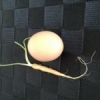-
Welcome to the eG Forums, a service of the eGullet Society for Culinary Arts & Letters. The Society is a 501(c)3 not-for-profit organization dedicated to the advancement of the culinary arts. These advertising-free forums are provided free of charge through donations from Society members. Anyone may read the forums, but to post you must create a free account.
Creating recipes
-
Similar Content
-
Recipe Bloopers 1 2
By heidih,
- 42 replies
- 4,446 views
-
Apple butter recipes 1 2
By gfron1,
- 30 replies
- 8,122 views
-
- 60 replies
- 8,802 views
-
- 4 replies
- 1,026 views
-
- 545 replies
- 70,286 views
-
-
Recently Browsing 0 members
- No registered users viewing this page.







Recommended Posts